Brameloup provides the ideal balance of nature and civilization. The large garden around the chalet (1000 square meters) and surrounding forest and meadows (another 7,700 square meters) provide access to nature close at hand. I always spend some time walking the trails I have built through the forest (see the forest page), or on the rural tracks or paths up to the village of Quincy above me, around the loop to Signy farm a kilometer away, or down to Frangy (see my neighborhood page). Gardening, digging in the soil, pulling weeds, and cultivating the beauty and diversity around me, make me feel an intimate part of nature. There are always new discoveries (see nature page and the four seasonal pages: spring, summer, fall, winter). The forest itself is constantly changing, with old trees falling and others growing to reduce my view. Ash dieback is a disease killing many ash trees in the forest, particularly those that grew densely on land at the bottom of my property that had been cleared then abandoned. Ivy spreads on the forest floor and climbs many tree trunks. This page describes some dimensions of my life at Brameloup and some events that have marked my time there. For my outside work in the garden and forest, see my activities page.
VISITORS
I enjoy having visitors, and can easily accommodate 15 people for meals (outside) and a few over night, but not many people venture up my difficult track. A few close friends have come, and even stayed over night.
Nabil Stendardo has come occasionally to spend the night.
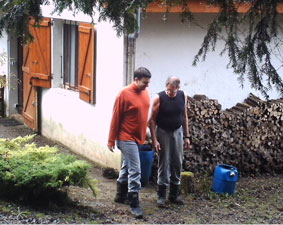 .
. 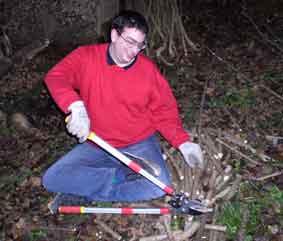
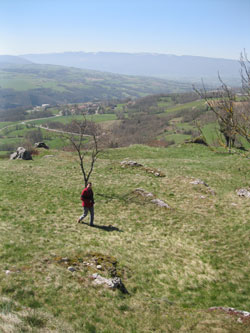 .
. 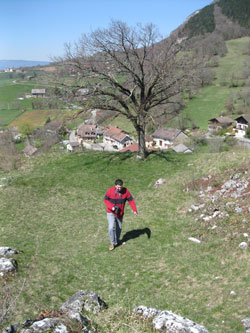 .
. 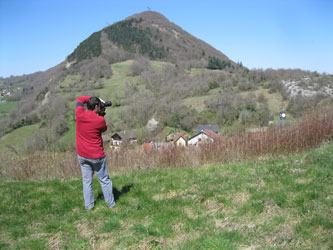
We go for excursions, such as to Chaumont across the valley. Nabil is an avid photographer
My brother Greg, his wife Emi and children Gregory, Joyce and Mina came for lunch and walks in the forest in August 2014.
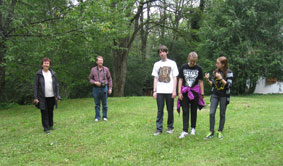 .
. 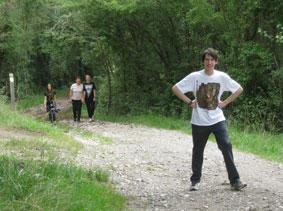
Emi, Greg, Gregory, Mina and Joyce in the garden; walking up to Quincy
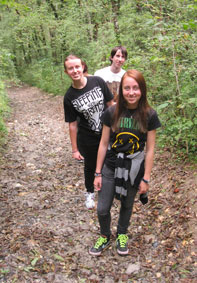 .
. 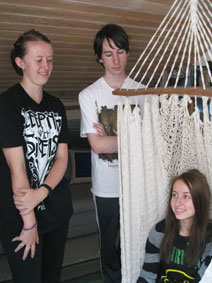
Mina, Gregory and Joyce
In July 2023, my son Alex and grandchildren Benjamin, Alie and Nalah came from Quebec on a short visit. I managed to clear all the trails through my forest so that they could enjoy nature before a raclette dinner together.
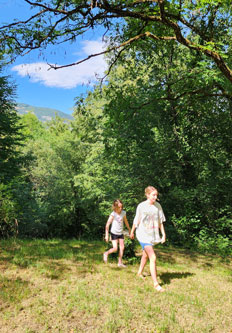 .
. 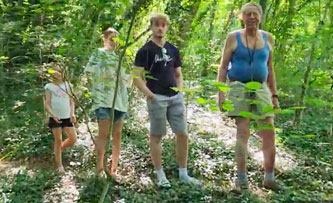 .
. 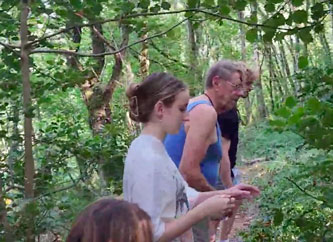
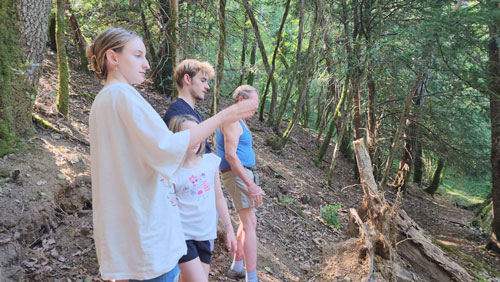 .
. 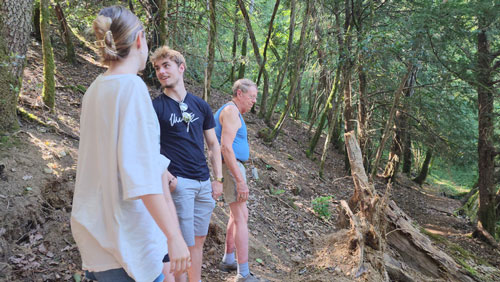
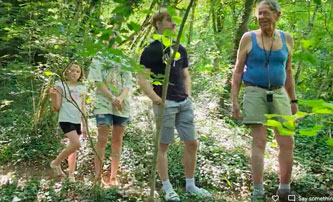
Grandchildren visiting my forest
For my birthday in August, my daughter, son-in-law and grandchildren also came to visit and enjoyed a walk through the forest.
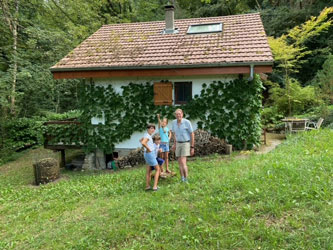 .
. 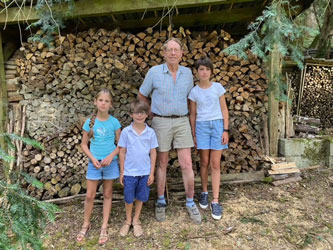 .
. 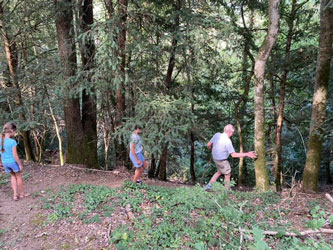
grandchildren visiting my chalet
FOREST MAINTENANCE
In early 2017, the electric company cut down trees growing too close to the electric wires across the ravine, leaving some in a precarious position down the steep slope, and piles of branches that I had to clean up.
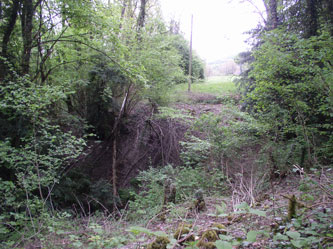 .
. 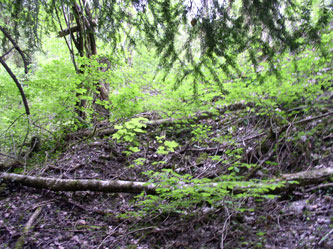 .
. 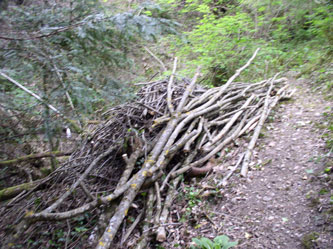
The cleared area across the ravine under the wires; tree trunks on the slope; branches and smaller trees cleaned up
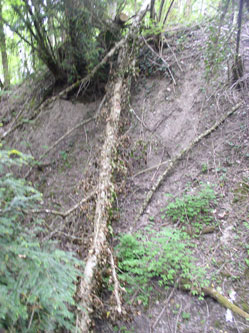 What do you do with a large tree top-down on a nearly vertical slope?
What do you do with a large tree top-down on a nearly vertical slope?
In late September 2020, when I got up in the morning, I saw that the electric line to my chalet was at a strange angle. Investigation showed that a large tree in my ravine had fallen on the wires, probably uprooted slowly because of the autumn rains and weighted down by heavy ivy growth. The electric company came quickly and, despite the steep slope inaccessible to any kind of machine, managed to cut sections of the tree gradually until it became vertical and fell off the wires. It took me more than a year to get around to cutting up the logs and branches where they were blocking my trails.
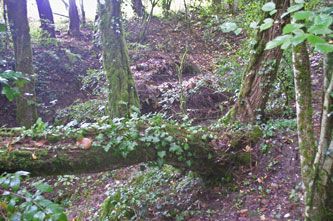 .
. 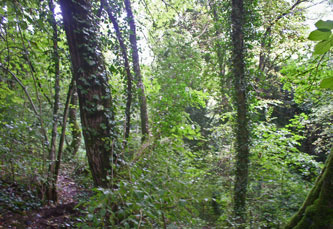 .
. 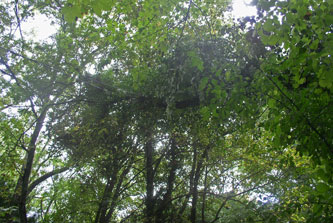
Tree uprooted at its base; the nearly horizontal trunk covered in ivy; treetop resting on the wires
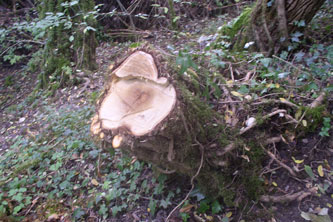 .
. 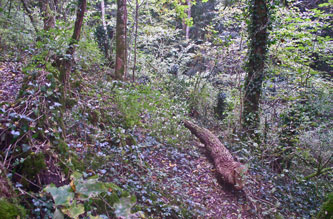 .
. 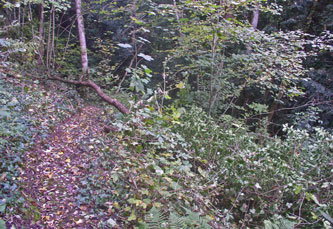
Stump after the cut with 50 tree rings; trunk on my lower trail; branches on my upper trail, already largely cleared
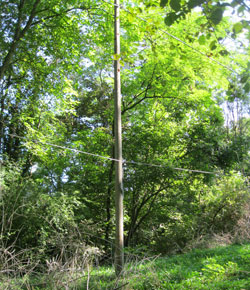
telephone line ripped from its pole by the falling tree
FALLING TREES
In the Fall of 2020, while I was unable to go to the chalet for months because of the pandemic, a large tree fell across the upper meadow because one side had rotted. I cut the remaining attachment to the stump, and began cutting up the branches, while waiting for better weather to start cutting up the trunk with a chainsaw. I finally cleared the meadow in the spring of 2021.
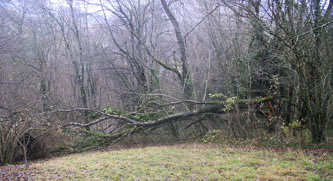 .
. 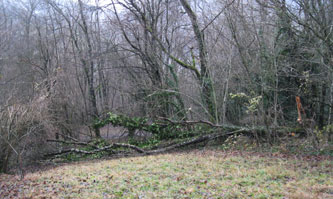
Fallen tree across the meadow; cut from the stump and starting to remove branches
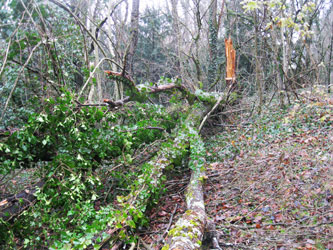 .
. 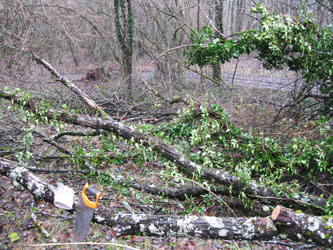 .
. 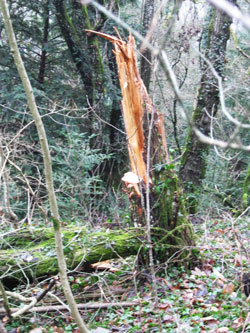
Fallen tree with some branches removed; removing branches; stump
On a calm sunny morning in October 2021, I was working at my computer when I heard a loud crack/crash nearby. Looking out, I saw that a very large tree from the edge of the forest above my chalet had fallen across my front garden and hedge, narrowly missing the chalet, bringing down several other trees, and completely blocking my entrance and the rural path that provides access to my property. It must have grown too far towards the light at the edge of the forest, and the wet soil could no longer hold its roots. A wall four meters high of vegetation and massive tree trunks reached from the forest across my front garden, which I could not cross even on foot. It was a living Robinia (false acacia) about 75 years old with heavy, dense wood and multiple trunks, 23 meters tall and 50 cm in diameter at breast height, far beyond anything I could remove by myself. I was trapped with no possible exit.
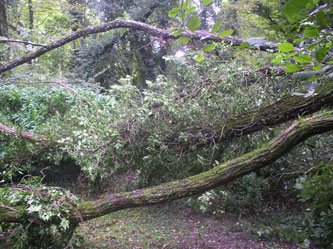 .
. 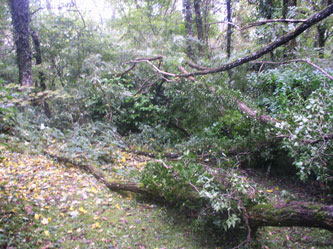 .
. 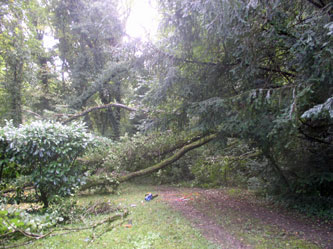
Fallen tree in the front garden; I had already started to clear branches (right) to see the damage on the other side
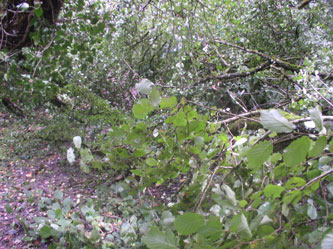 .
. 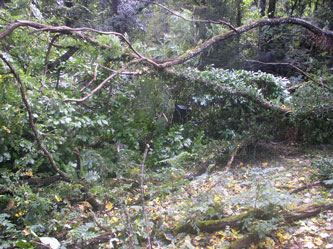 .
. 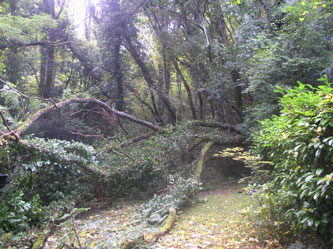
The fallen tree brought down several other smaller trees; tree with multiple trunks blocking the driveway
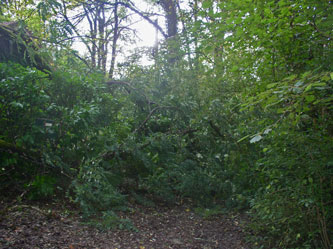 .
. 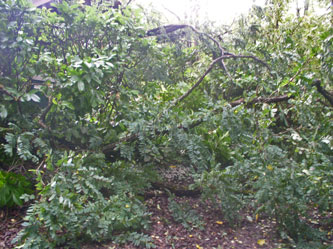 .
. 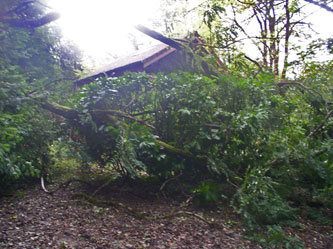
Road blocked completely by fallen tree; tree across smashed front hedge
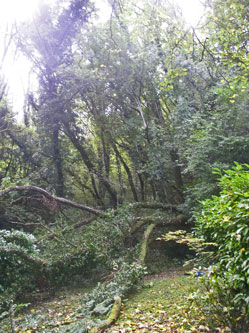 .
. 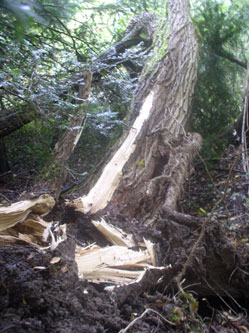 .
. 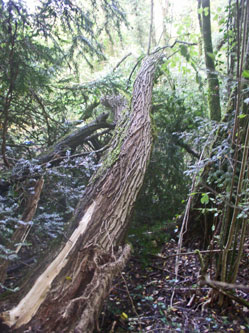
Tall forest behind (beyond my property) from which the tree fell; uprooted tree base and main trunk 50 cm in diameter
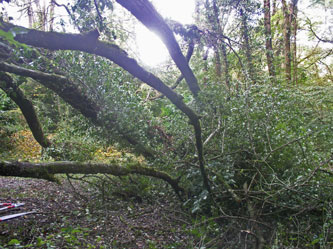 .
. 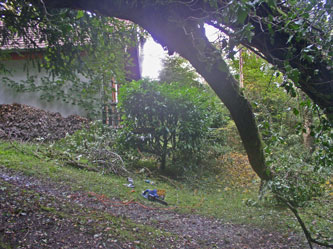 .
. 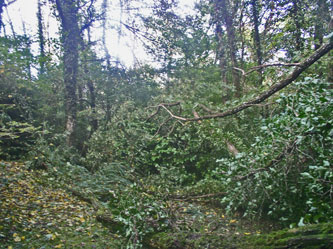
Fallen tree across driveway; relatively near miss (3 meters from the chalet); front yard filled with the fallen tree
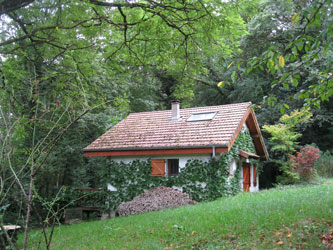 .
. 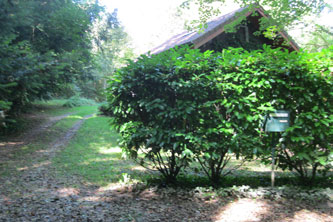
BEFORE: Chalet with the forest behind, from which the tree seen just above the chimney fell two weeks later; hedge before being smashed
Fortunately I had a few days reserve of fresh food and nothing urgent in Geneva. I finally reached my municipality of Musièges the next morning, and the local technician came out immediately (with some difficulty since no one knows that the village has some land across the river where I am the only inhabitant). After a long morning's work, he had cut up the tree, and I spent the next two days clearing many of the branches. The next generation will inherit some excellent firewood.
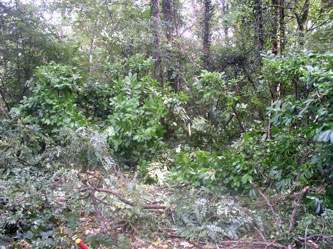 .
. 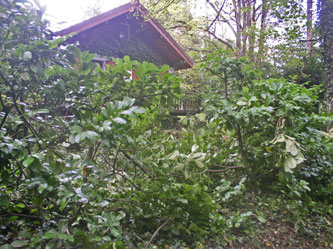 .
. 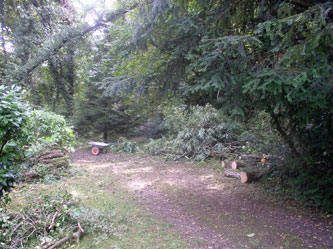
Logs and branches after the woodcutter left; smashed hedge; driveway cleared
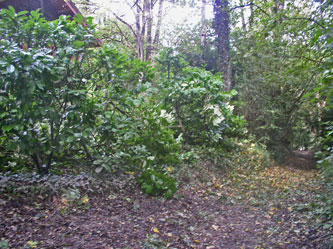 .
. 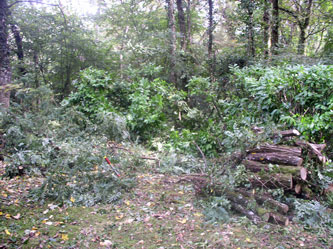 .
. 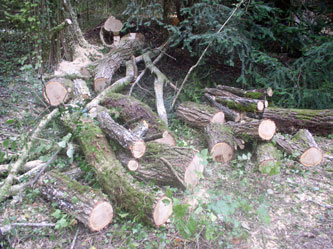
Cleared road to the right of the smashed hedge; front yard before I removed branches; cut up tree trunks
The unusually mild winter of January 2023 with considerable rain in mid-winter softened the soil so that strong winds blew down a number of trees in my forest. In particular, a large dead and rotten oak tree perhaps a meter in diameter just above the upper edge of my property finally fell downhill, uprooting and taking with it at least three other large living oak trees. These oaks in turn knocked down other trees, making a wall of fallen trees and branches completely crossing my property from south to north and blocking the three trails giving access to half my land. I had to dig around the stumps and roots at the top, and cut through the branches at the bottom, to restore two of my trails but I was afraid that I could never use the middle trail the length of my property again.
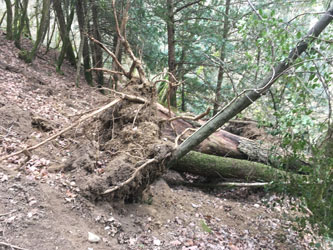 .
. 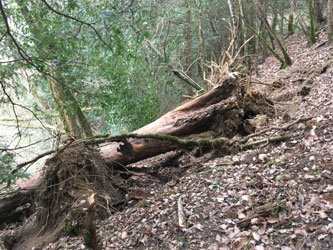 .
. 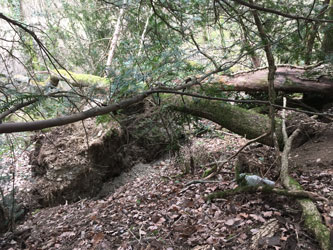
Fallen trees at the top of my property; the old oak; uprooted trees
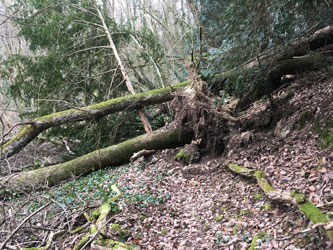 .
. 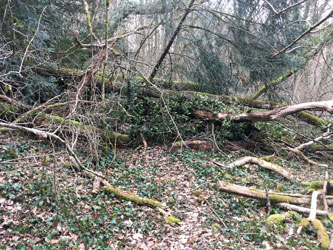 .
. 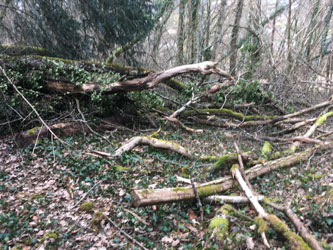
Uprooted trees knocked down by the old oak; the trail in the middle completely blocked by four tree trunks; fallen trees
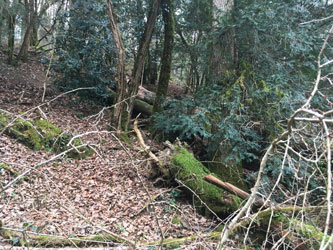 .
. 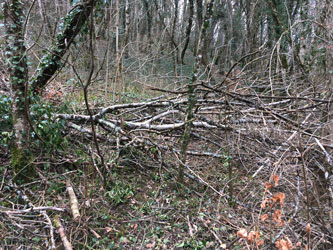 .
. 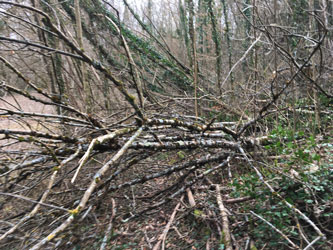
View up at fallen tree trunks; upper tree branches across the trail at the bottom of my land
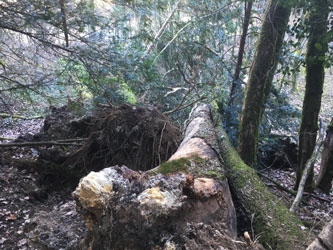 .
. 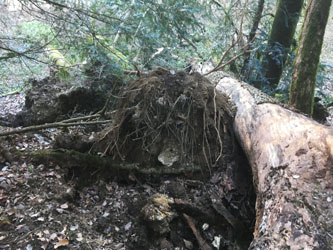 .
. 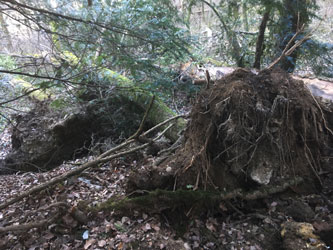
Four fallen trees crossing my land, one dead and three living; mature oaks completely uprooted
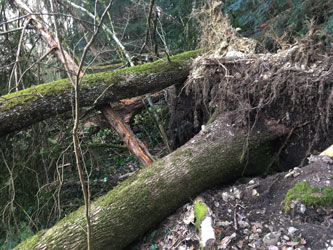 .
. 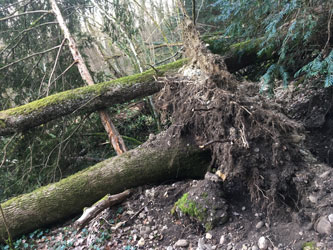 .
. 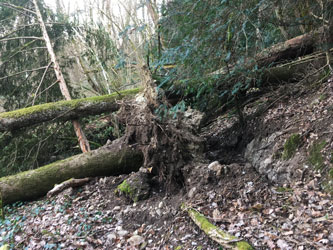
The fallen trees have completely blocked the trail through the middle of my land, with large disks of roots and soil at their base; this was the trail in the middle of the photo
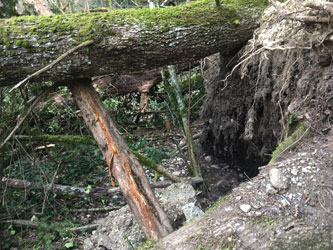 .
. 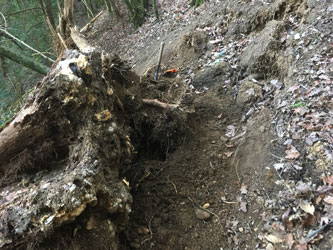 .
. 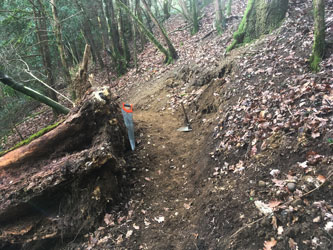
Middle trail with wall of trunks; starting to rebuild my upper trail around the stumps with roots to cut; finished trail around the stumps
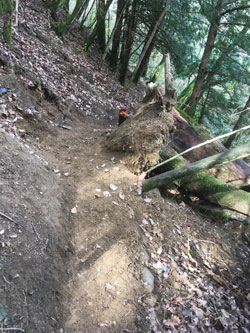 .
. 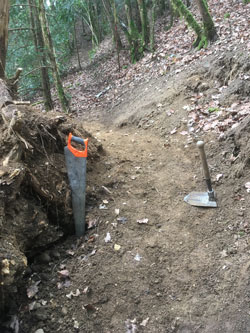 .
. 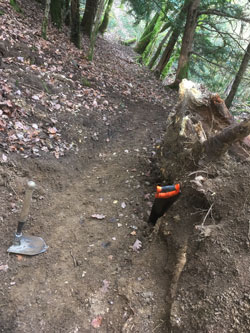
Finished trail up and around the tree stumps
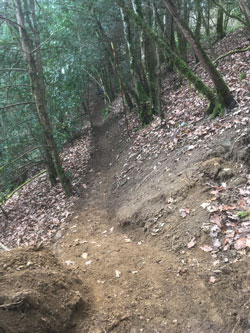 .
. 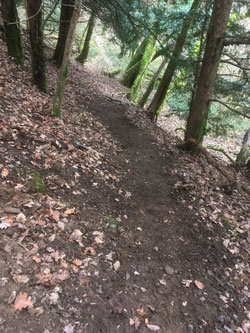 .
. 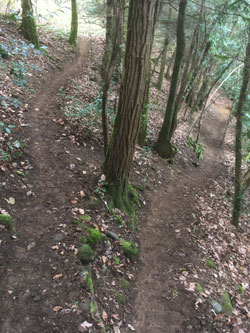
This was an opportunity to clean and rebuild the upper trail along my land
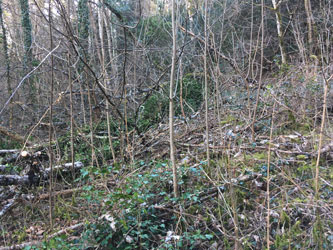 .
. 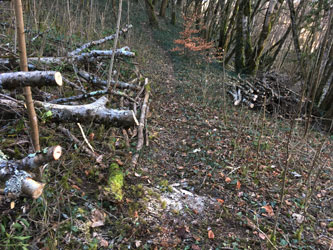 .
. 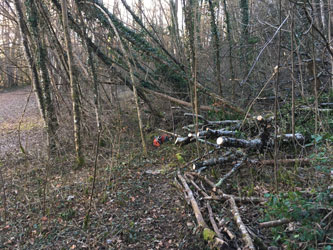
Wall of fallen trees across the lower part of my property with branches reaching to my lower limit; lower trail cleared with tree branches cut back
Finally, in August 2023, I found a way to rebuild the middle trail by digging behind the root disk of the lowest oak tree and passing under the other three
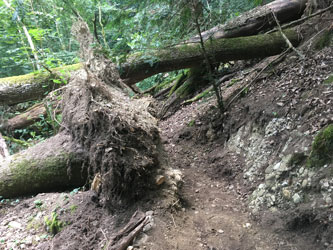 .
. 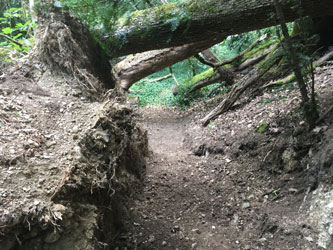 .
. 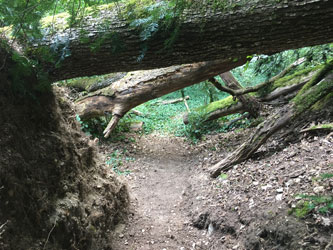
Middle trail rebuilt behind one root disk and under the other three fallen oak trees
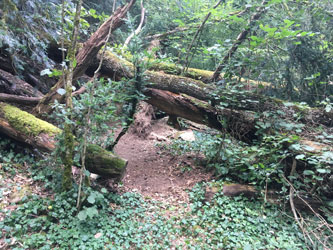 .
. 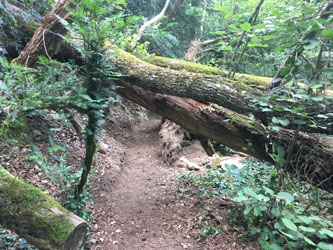 .
. 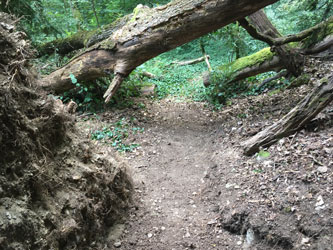
Middle trail rebuilt to pass under the fallen oak trees
I found two smaller Robinia (false acacia) trees that had also fallen downslope across the middle trail, making about ten large trees in all fallen down since the beginning of 2023, perhaps a sign of stronger thunderstorms with climate change
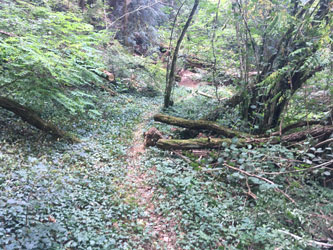 .
. 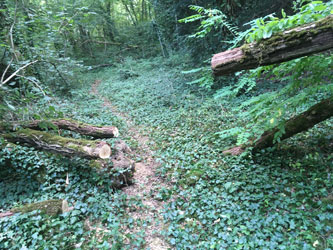
I had to cut two smaller trees also fallen across the trail
See also trail building on my chalet activities page
Perhaps it is a sign of climate change that extreme weather events are more frequent. After a February with a record no rain in France for a month, my forest was hit by extreme weather, probably a thunderstorm with high winds, in March 2023. It snapped a tall poplar tree half way up, falling across the top of my meadow and blocking a trail, and broke the top off another tree in my lower forest. It uprooted another large oak at the top of my property, blocking my upper trail. Two trees also fell across the road up to my chalet, one large tree still suspended over the road on some smaller hazelnut trees but ready to fall at any time. I called the municipality to clear those from the public right-of-way. They cut the lower one but left the larger tree hanging. In early May I managed to clear the fallen poplar from my meadow, and the remainder of the trunk tilted upwards where it is suspended in another tree.
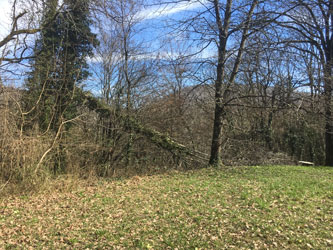 .
. 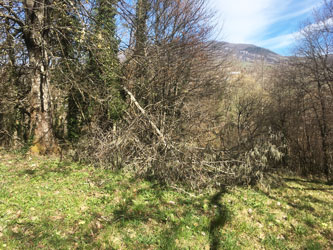 .
. 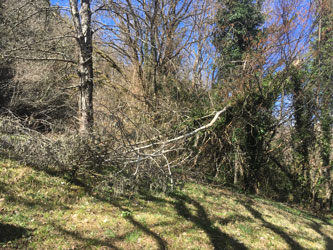
Poplar tree fallen in my garden meadow but still attached to its trunk; with many branches in its healthy top
The oak that uprooted pushed over some small trees and blocked my trail completely.
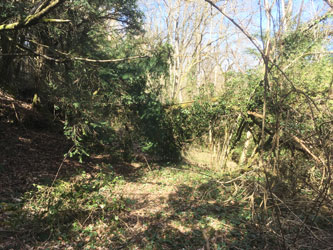 .
. 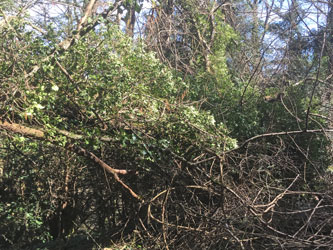 .
. 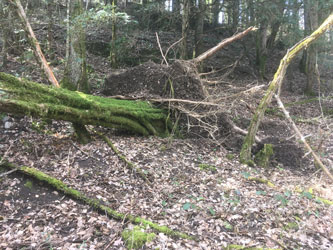
Large oak across start of upper trail; great mass of branches and ivy; the lower trunk uprooted
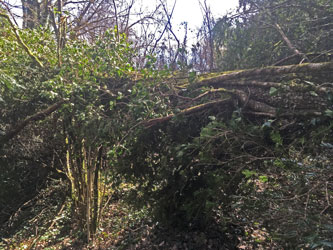 .
. 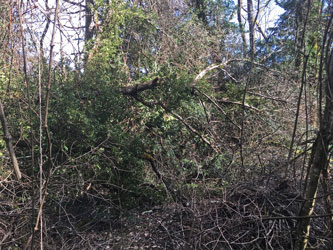 .
. 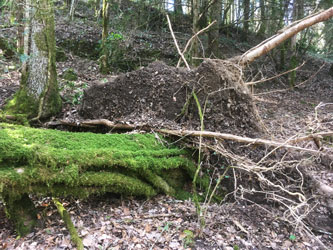
Mass of trunks and branches blocking my trail; tree top with mass of branches; uprooted tree with massive vines of ivy that may have weighed it down.
In late May 2023, I managed to cut through the big fallen oak across the trail out of my garden, as well as another dead tree that fell across the meadow and a smaller hazelnut tree that fell across the road up from my chalet just beyond my property.
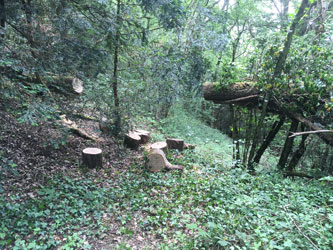 .
. 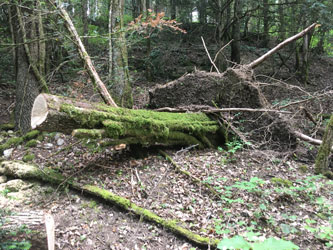 .
. 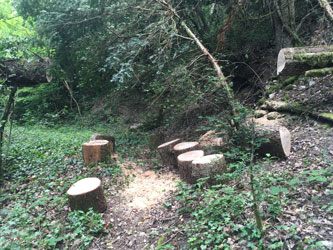
Fallen oak across the upper trail, cut to allow passage
The tree in the lower forest broke off near the top and just missed my trail down.
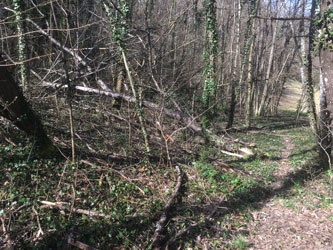 .
. 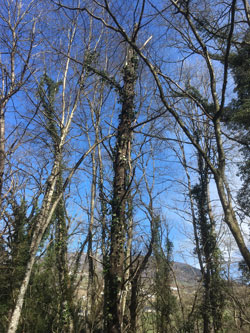
Treetop fallen in lower forest; trunk in centre from which top fell
The trees blocking and threatening my lower road could make access impossible. Fortunately my small car could just pass under the horizontal tree for the moment.
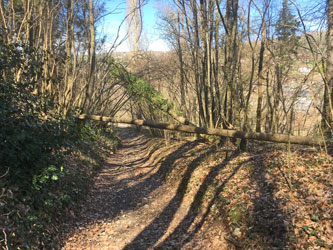 .
. 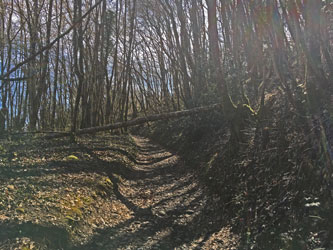 .
. 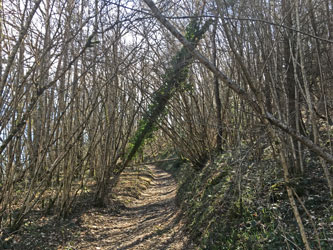
Trees across lower road, one horizontal, the other diagonally across the road
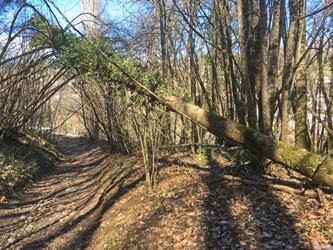 .
. 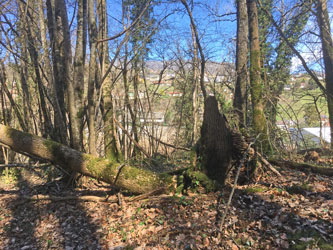 .
. 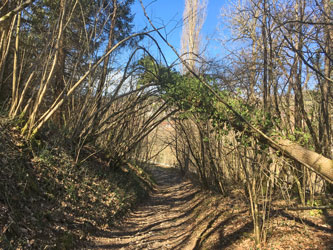
Large tree resting on hazelnuts on other side of road; broken off near the base
The night of 25 July 2023, a severe thunderstorm with high winds and hail passed over Brameloup. When I went to the chalet three days later, I saw that many large trees had been blown down across the road to my chalet, and had fortunately already been more-or-less cleared by the municipality. Arriving at the chalet, the driveway was completely blocked by a treetop 9 metres long with a trunk 25 cm in diameter, and another fallen leafy branch, from the large field maple tree (Acer campestre) behind my woodshed. A branch had also been ripped off the Robinia (false acacia) between my garden and the meadow. Fortunately neither my chalet nor my woodshed were damaged, although a wall of vegetation and suspended branches completely hid the woodshed. Clearing these took three days' work, two days to remove all the small branches and leaves from the maple treetop and pull it to ground level, and the third day to cut it up with a chainsaw. The garden and trails were littered with leaves and small branches after I had just cleaned them all for my son's visit.
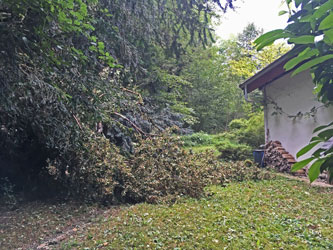 .
. 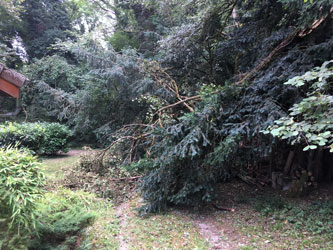 .
. 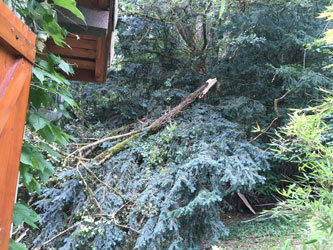
Large fallen leafy treetop and branches across my driveway next to the chalet; trunk resting on other tree branches
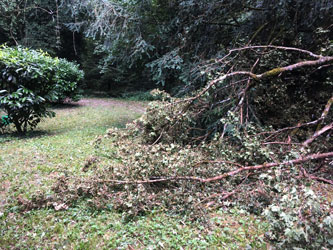 .
. 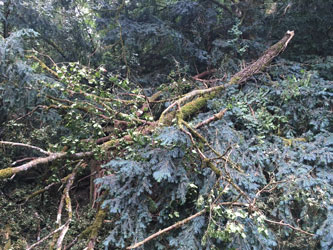 .
. 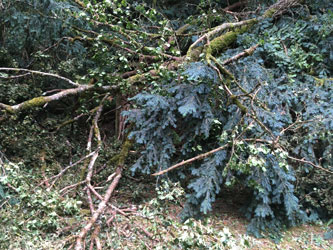
Fallen branches, completely hiding my woodshed with a wall of vegetation
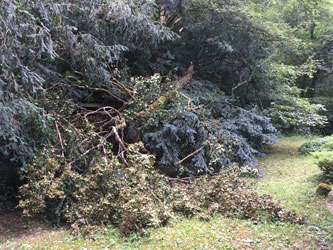 .
. 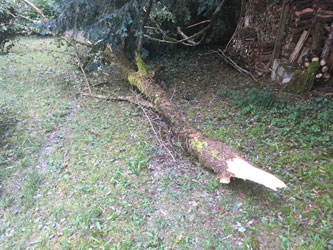 .
. 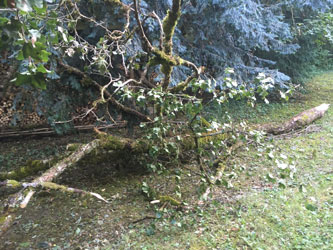
Fallen branches suspended on other trees; treetop trunk with leaves and branches removed two days later and brought down to the ground so I could cut it up
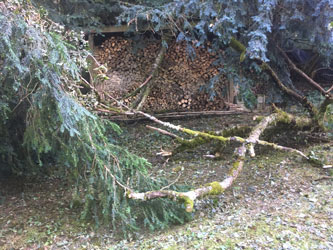 .
. 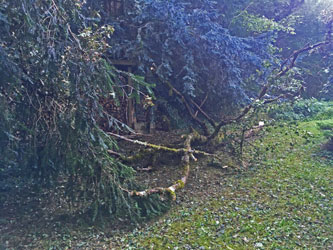 .
. 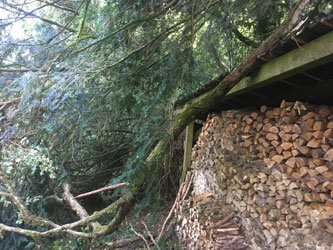
Fallen treetop after leaves and branches removed; second fallen branch on woodshed
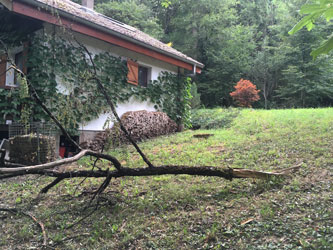 .
. 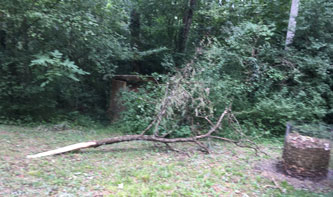 .
. 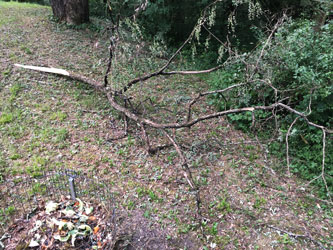
Branch from Robinia that fell near my tool shed
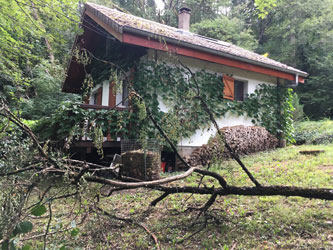 .
. 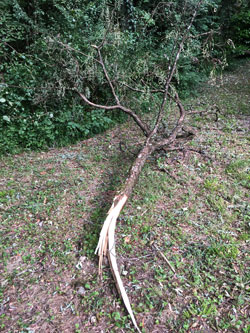 .
. 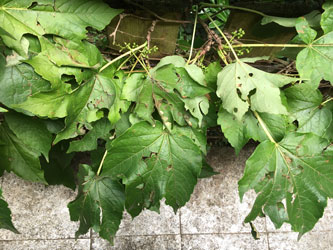
Branch from Robinia; leaves on my balcony damaged by hail
The next week a large oak branch had fallen across the road up to my chalet, which is why I always carry a saw in my car.
2023 was really the year for falling trees. In late November, I found more big fallen trees. Just beyond the west end of my property, several large oak trees were uprooted, falling down slope, much like those that fell across my land in January.
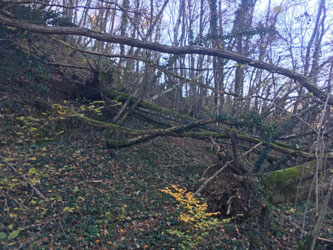 .
. 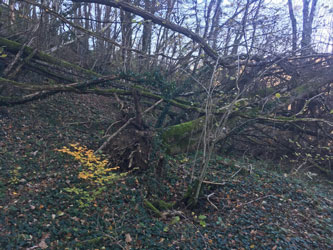 .
. 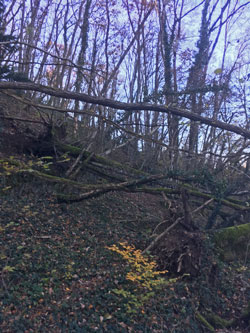
Several trees fallen downslope just beyond my property
At the east end of my land, another large tree was uprooted in the canyon of Brameloup stream, falling across where I pile branches to hide the five old cars dumped by the farmer up the hill, and extending into the pasture beyond my property. It blocked two of my trails down the canyon. One trail to the pasture is permanently blocked. The other down the canyon was blocked by the raised root disk. With some effort I was able to dig around and through the raised root disk and clear the trail down the canyon.
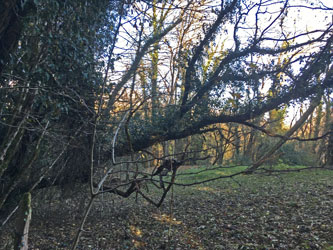 .
. 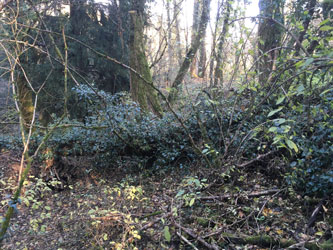 .
. 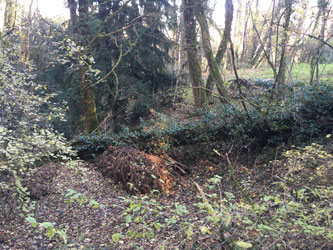
Large tree fallen across canyon and into pasture next door
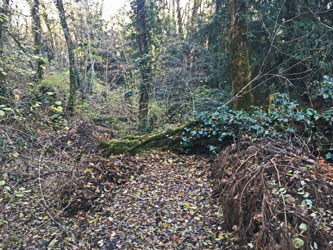 .
. 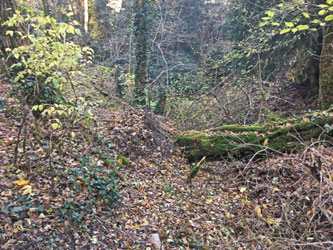 .
. 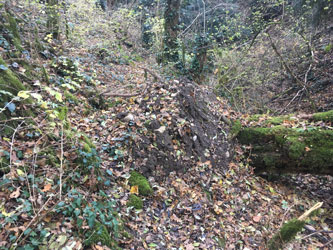
Root disk of fallen tree blocking my trail
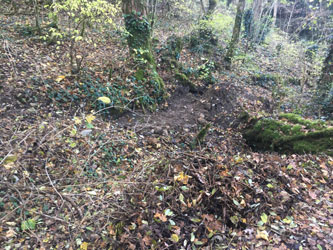 .
. 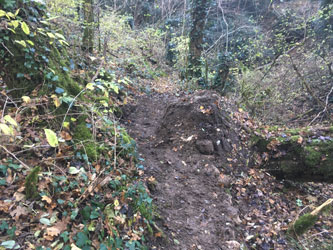
Raised root disk cut through for trail to pass
The saga of trees falling on my electric and telephone lines continued in December 2025, with major consequences. I was quietly working in my chalet on a quiet 9 December evening when I heard a loud noise in my attic, like something heavy falling. I went upstairs and saw nothing. I walked around outside with a flashlight with no sign of any problem, so I went to bed. I began to wonder if the chalet was haunted by a ghost going thump in the night. The next morning there was no connection to the telephone or Internet. I went outside and saw that my electric and telephone lines sloped down sharply beyond my canyon. Two large trees along the pasture fence line had fallen across the wires, ripping them from the nearest post and bringing them to the ground. The electric line under great tension still worked, but the telephone wire was ripped from my chalet and stripped of insulation. The cement post nearest my chalet leaned towards the fallen trees under great tension. The noise in the night was the wires jerking and breaking.
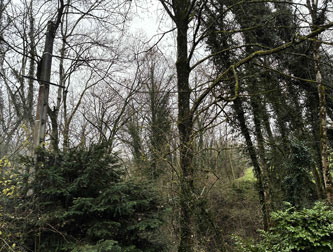 .
. 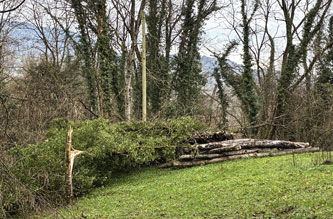 .
. 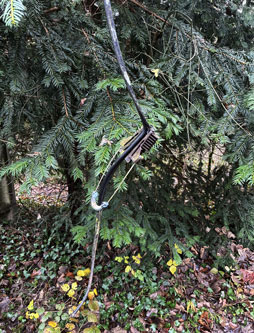
Wires down across canyon; fallen trees over wires; broken telephone wire
The electric company responded quickly and surveyed the damage. The phone company sent a technician the next week who made a temporary repair. Finally the electric company decided to replace the whole line and poles from across the river to my chalet. They marked 7 trees between my chalet and the pasture for removal, and several others too close to the wires along the pasture. This would take two weeks in January, when I should be able to provide before and after pictures of the loss of a significant part of my forest.
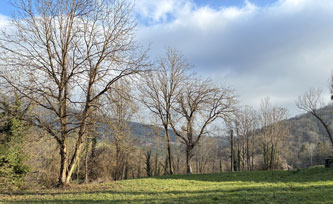 .
. 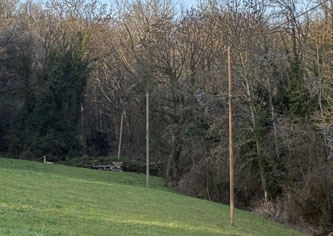 .
. 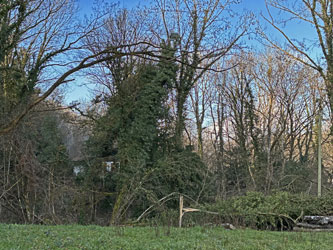
Three large trees in pasture to be cut; poles and wires downed by fallen trees; fallen trees over wires, my chalet through the trees in the background
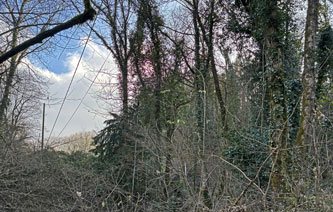 .
. 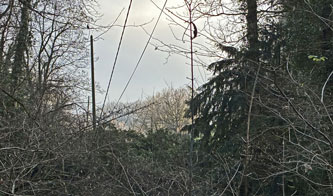 .
. 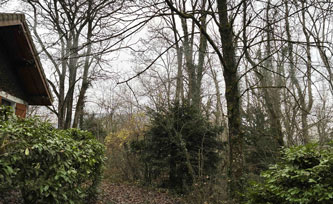
Fallen wires seen from chalet; fallen wires under trees; chalet with leaning pole, stretched electric wire and broken telephone wire
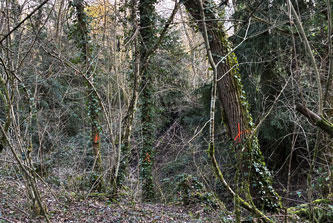 .
. 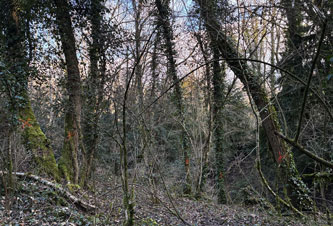 .
. 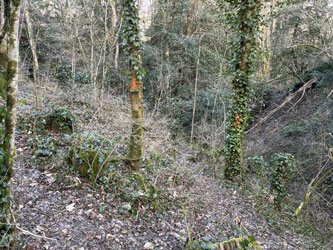
Trees beside my trails marked for cutting; five big trees to be cut; trees along my trails marked
 .
. 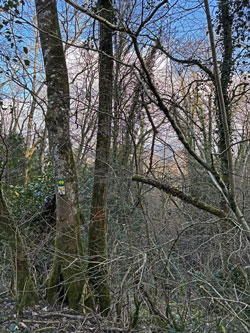 .
. 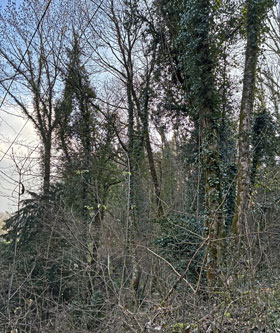
Tall trees covered in ivy to be cut; tree beside my road marked for cutting; trees that will soon be gone
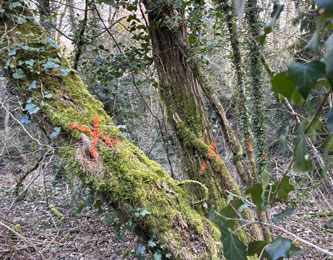 .
. 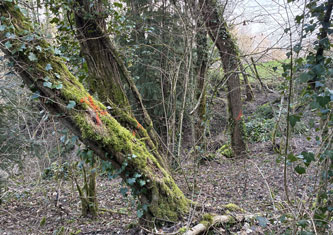 .
. 
Old trees along my road marked for cutting; trees on both sides of ravine to be cut; tree with metal band, possibly for pole across road
RURAL TRACK (CHEMIN RURAL)
My chalet is on a rural track or path which is a public right-of-way that cuts diagonally across my property, separating the ravine and lower meadow from the rest. The track is prohibited to motor vehicles, but that does not stop the occasional motorcycles, quads or all-terrain vehicles from using it. Most of the passers-by are hikers, horseback riders or trail bikers, and it is an official departmental walking and trail bike itinerary. I do most of the maintenance myself (see activities page).
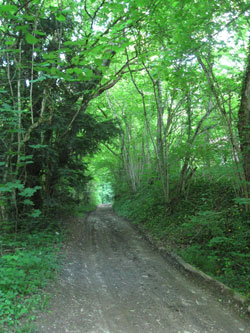 .
.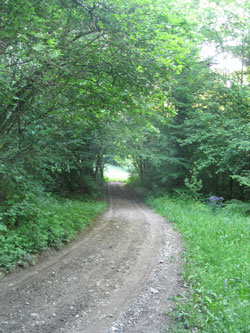 .
.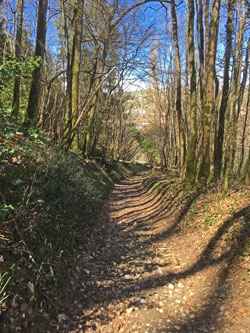 .
.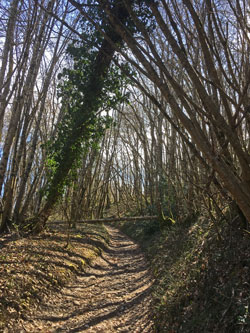
Vehicle track up between my chalet (right) and the ravine (left); track down with lower meadow on the right; track in winter near the bottom with fallen trees
The village of Musièges organizes an annual 24 kilometre trail run in September from the village down across the Usses River, up to Quincy, and down along my track before going on to Frangy, up to Chaumont, around Le Mont and back to Musièges. They even use a trail I built to bypass a difficult section above my chalet. On 22 September 2019, I watched the runners pass by my chalet.
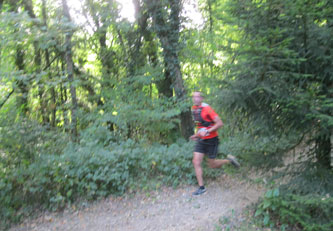 .
. 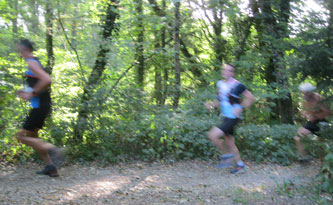 .
. 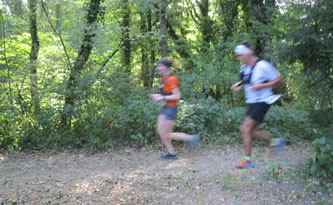
Trail runners passing by my chalet
GARDEN AROUND THE CHALET
The immediate area around the chalet is mostly lawn, or at least mowed vegetation since I have never planted grass, with some limited landscaping to screen the chalet from the rural path, a little garden with table and chairs in front of the chalet, some fruit trees, two woodsheds, a toolshed, and the vegetable garden at the far end of the large lawn in front of the chalet. The mowed area is about 800 square meters. There is forest on most sides, except where the lawn drops down into the upper meadow, with a view to the North across the valley of the Usses River to Mount Vuache on the other side.
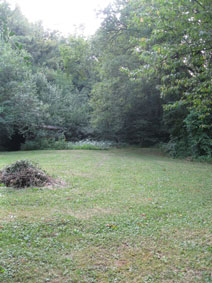 .
. 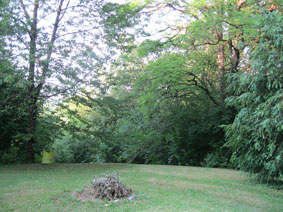 .
. 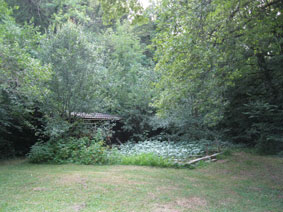
Large lawn in front of the chalet, reaching to the vegetable garden, with fire circle in the middle
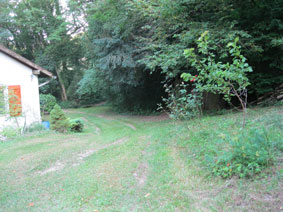 .
. 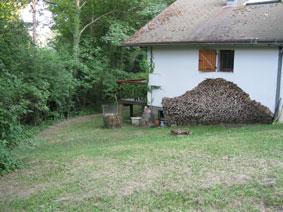 .
. 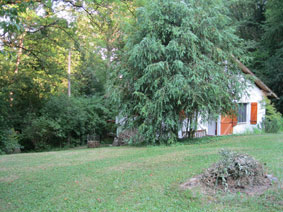
Lawn around the chalet
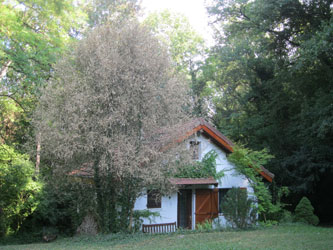 .
. 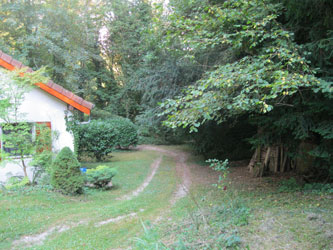
In 2018, the large boxwood was decimated by caterpillars (pyrale du buis) and had to be removed; driveway by the chalet
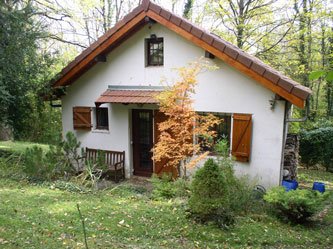 .
. 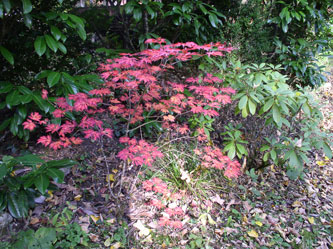 .
. 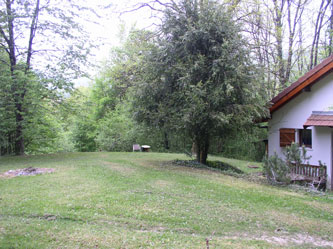
Garden in front of the chalet; a Japanese maple in the garden; lawn looking north towards the meadow
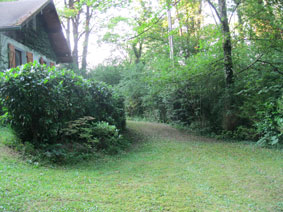 .
. 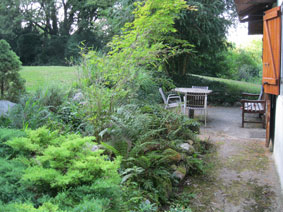 .
. 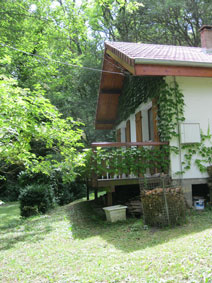
Lawn below the balcony; front garden; balcony I built myself, with compost bin in front
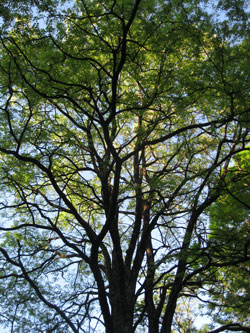 .
. 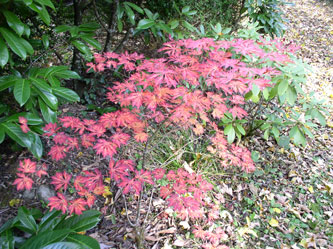 .
. 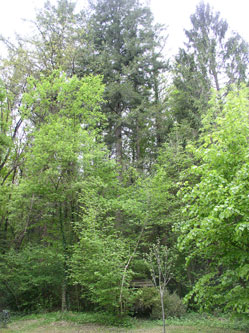
The magnificent Robinia (false acacia) next to my chalet; autumn colours in the garden; my water tank and the Douglas firs to the south above my land
Climate change has hit. The drought and extreme temperatures in the summer of 2022 nearly killed rhododendrons I had planted in my garden and caused many other plants and trees to die back. With the water shortage, we were not allowed to water our gardens. February 2023 was the longest period without rain ever in France.
SNOWSHOES IN WINTER
I love walking through the forest and fields in all seasons, but when the snow is too deep for walking, I can go out with my snowshoes to get some air and sun. It is actually easier to go up and down the slopes in snowshoes, but they are not so good on my narrow trails.
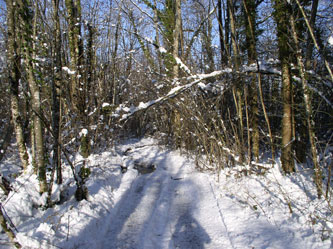 .
. 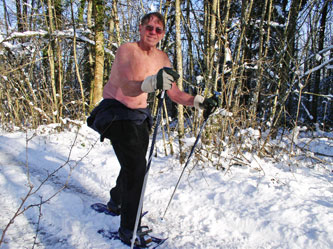
Going up the upper rural track to get some sun and exercise in winter
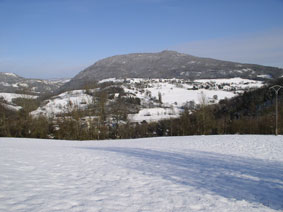 .
. 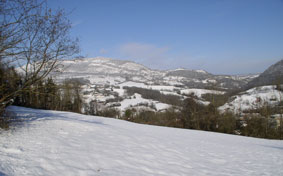 .
. 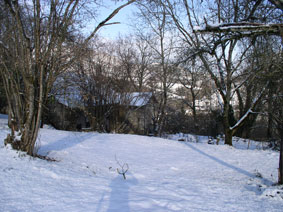
Views of Musièges and Frangy from Signy farm, and the old farmhouse on my snowshoe circuit through Signy
AT HOME IN MY CHALET
My chalet at Brameloup is both a refuge and a workplace where I can concentrate on writing without distractions. I have a music system with records, cassettes and CDs, radio (but no television), an extensive library of literature, art, history and natural history for recreational reading, as well as my scientific library and document collection on environmental issues, islands and coral reefs. I finally had to install an Internet connection to keep from having to return to Geneva for on-line meetings. There is both a downstairs work-space open to the balcony with a view of the forest, and an upstairs work-space with my scientific library and documents. I try to alternate a couple of hours work with a similar time in the garden or forest (see activities), since sitting for hours has been shown to be very unhealthy.
 .
.  .
. 
The old computer (now upstairs) hosts my islands database; me at my downstairs workspace; library of literature and biography
I try for a simple lifestyle, with efficient and economical use of power and water, rainwater catchment for the toilet and garden, only organic gardening, and composted waste (see my sustainable lifestyle page). Most of the heating comes from wood I cut myself on the property (see activities page). I carry it in a handmade Samoan basket that has survived heavy use for more than 20 years. My food is locally sourced when possible, including cheese and butter from the cheese factory just across the river, and eggs from the next town. I also minimize my use of clothing to reduce power and water consumption and water pollution from washing clothes.
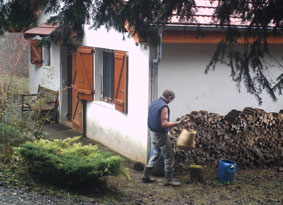
Fetching firewood in the winter
Waffles
It has been a family tradition since the 1930s (when my parents received 3 waffle irons as wedding presents) to have waffles with maple syrup on Sunday morning, usually accompanied by fresh orange juice. I still continue the tradition when my schedule permits, using the same type of waffle iron my parents had from the 1930s (which I have to repair from time to time). The batter is prepared with egg, milk, self-raising flour, salt and melted butter, mixed with a hand-powered egg-beater. Since pure maple syrup is too expensive, I make my own, 3 parts sugar boiled in water, one part maple syrup, to avoid all the additives in commercial syrups.
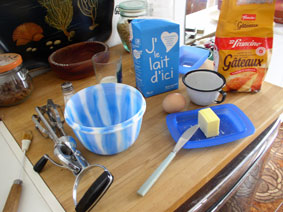 .
. 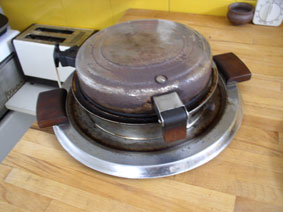 .
. 
The ingredients; the waffle iron; mixing the batter
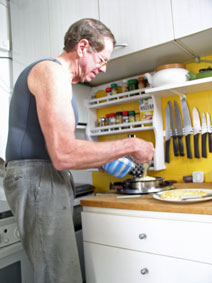 .
. 
Spooning the batter onto the waffle iron; the finished waffle
Another favorite evening meal is raclette with melted cheese from the factory down the hill served over potatoes, which I tried to grow in my garden with only temporary success.
FIXING MY TAPE RECORDER
 I bought a used tape recorder to digitize old reel-to-reel tapes in my archives, but when I first started to use it, the tape would not play. On opening the tape recorder, I found that the cast metal piece that moved all the levers to play and record had disintegrated. Knowing that finding someone to repair such an old machine would be impossible, I scrounged in my collection of old things that might be useful some day, found a brass doornob of the right shape and thickness, and spent an afternoon crafting a replacement piece. By evening I could play tapes on the machine again.
I bought a used tape recorder to digitize old reel-to-reel tapes in my archives, but when I first started to use it, the tape would not play. On opening the tape recorder, I found that the cast metal piece that moved all the levers to play and record had disintegrated. Knowing that finding someone to repair such an old machine would be impossible, I scrounged in my collection of old things that might be useful some day, found a brass doornob of the right shape and thickness, and spent an afternoon crafting a replacement piece. By evening I could play tapes on the machine again.
It is times like this that confirm my tendency not to throw things away. You never know what else they might be good for. Many of the materials for the chalet were recycled.
 .
. 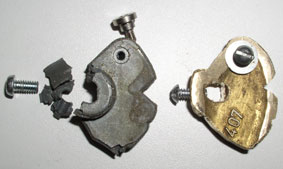 .
. 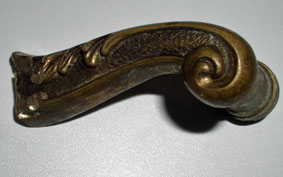
The play/record lever in the center; the broken part and its replacement; the remaining half of the doorknob
THE WATER SAGA
Part one
When I bought the chalet, I was told that water was supplied from the Frangy water system through a pipe on a cable across the Usses River; only the pump needed replacing. However, a new highway bypass had been built around Frangy, so the whole installation had been moved. It took me two years to get the water connected.
First the old mayor of Musièges (he had been mayor for 47 years) got the village meter reader and went with me to find where my water meter had been moved to after the road construction. We found it under a manhole cover in the Bonnets economic activities area next to the river. However when we turned on the water, it came shooting out of a plastic pipe about 10 meters away. The contractors had laid a cast iron pipe under the river bed, cemented in with large boulders, and run the plastic pipe through it, but had failed to connect that pipe with the one from the water meter. The mayor had the contractor come back, dig up the pavement to find the other end of the pipe, and make the connection. A few months later, we went back to the meter and turned on the water, only to see water coming out of a pipe in the air on the other side of the river. That end had also not been connected to my pipe coming down the hillside, and no one knew where my pipe was. I searched for weeks down the hillside and along the river bank where the pipe on the cable must have crossed the river, without success. Finally the new mayor (the old mayor's son-in-law) jumped on his tractor, found the village water diviner, and came hunting with me for my pipe. We started at the pump box at the edge of my property, and walked down through the forest, as the water diviner's two bent wires swung to show where the pipe was, down the steep hill, across Brameloup stream bed, across a corn field, and to the river bank some ways down stream from the pipe crossing. The water diviner looked over the edge, and saw the (empty plastic) pipe sticking out of the bank in the bushes. The mayor arranged for a contractor to come, dig a long trench, and connect my pipe with the new one crossing the river.
Finally I thought I had water. I went to the valve in my pump box, opened it, and listened to the air pressure from the rising water, but no water. I went back to see the mayor, and some inquiries showed that Frangy had installed a new water treatment system below the spring on Mount Vuache, and the new system was 20 meters lower than my chalet, so there was no longer enough pressure to reach me. We came back with the water diviner to find how high up in the forest the water came in my pipe, and he showed me where to dig. He was accurate to within 70 cm. I found the pipe, dug a trench down the hill to lay an electric wire, and installed a pump box and pump in the forest to bring the water up to the old cement water tank of one cubic meter behind the chalet. I then rebuilt the cracked water tank, adding a fiberglass lining, and gave it a proper cover and roof. I later added a floating switch, so that the pump would switch off when the tank was full, after I burned out one pump by leaving it on too long (see Chalet maintenance). Finally, after two years, I had water.
Part two
Eight years later, I noticed one day that the pump did not turn off when the tank was full, and was still running some hours later. A quick check showed that there was no water. I walked down the hill looking for any sign of a leak or broken pipe, and saw that the corn field had been deeply plowed where the pipe crossed it. I called the mayor of Musièges, and he said they had done nothing that might have cut off the water, so he gave me the name of the owner of the field, who in turn referred me to the brothers who farmed it. They said they had not plowed more deeply than usual. I was beginning to think that I would have to pay a contractor to go digging across the field looking for a cut pipe, or else lay a new pipe around the field. I went to the water meter to cut off the water in case it was leaking underground, and found that it had been turned off. On further inquiry, I found that while Musièges, as my commune, was responsible for the connection, it was Frangy that actually supplied my water. I went to the Mairie in Frangy, and was told that they had found a water meter but did not know who it belonged to, so they turned it off so that the owner would appear. It never seemed to have occurred to them to ask Musièges, and Musièges had never told them that I had a water connection. This was the first that I knew that Frangy should have been billing me for water. I gave them my address, and turned the water back on, but three days later when I checked the pump, it was drowned in water. Dismantling everything, not only was the pump burned out from running dry for several hours, but the heat had melted the connections to the plastic pipe, which had already leaked 4 cubic meters of water (compared to the 197 cubic meters I had consumed in the previous eight years). I had to install a new larger underground pump box and a new pump, and replace all the connections, before I again had water.